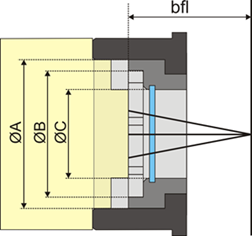IDS Software Suite 4.96.1
Some C-mount lenses reach deep into the camera flange. This may cause the lens to push against the back of the filter glass inside the camera or even make it impossible to screw in the lens.
The table below indicates the maximum possible immersion depth. The actual immersion depth of a lens is given in the relevant data sheet. As lens parts with a small diameter are allowed to reach deeper into the camera flange, the immersion depths are specified based on the diameter (named as A, B, and C in the image below).
Beside the immersion depth also the back focal length has to be considered, that means the distance between the last lens and the sensor (named "bfl" in the image below). The back focal length can be calculated for C-mount with the following formula:
x stands for the maximum immersion depth (see table below).

Fig. 575: Camera front (sectional view)
 |
The data given in the table include the following tolerances as a safety clearance: •Immersion depth: 0.2 mm •Diameter: 0.2 mm |
Type |
Thread depth (min.) |
for diameter at lens end [mm] |
resulting max. immersion depth [mm] |
min. required back focal length [mm] |
|---|---|---|---|---|
Ø A, B, C |
CMOS |
CMOS |
||
C-mount (as from March 2020) |
5 mm |
24.0 |
10.0 |
7.5 |
C-mount (until March 2020) |
5 mm |
24.0 |
7.2 |
6.8 |
20.4 |
9.7 |
|||
14.6 |
10.7 |